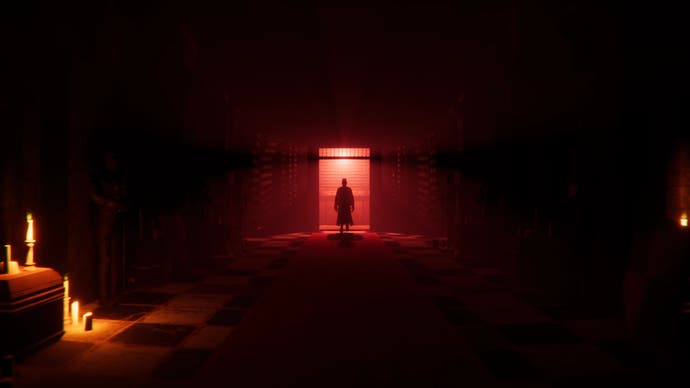El Paso, Elsewhere review - hectic monster blasting with killer style
Motel shootout.
El Paso, Elsewhere is beautifully simple. It's a third-person action game in which you fire guns and dive through windows, triggering bullet-time as you whittle down ranks of converging foes. Its levels are labyrinthine, its hunger for carnage is nearly endless. It's a thrilling challenge at the standard difficulty and thoroughly cathartic if you drop down the damage you receive, set the ammo to infinite, and just thrash away in the abyss. All of this, yes, but what's special about El Paso is how it's been dressed up.
It comes in layers. A noir hero in a trenchcoat enters a motel and rides the elevator down to hell, stopping at every level along the way. Twin pistols, blocky outlines, fizzing, flickering shadows: at first it feels like a Stranglehold PS1 demake. The character models have the odd silhouettes and triangle noses of early Tomb Raider, while muzzle-flashes are lovingly ragged and pixelated at the edges. Environments have walls and floor and - most often - no ceiling, revealing a twisting Llamasoft sky, while each stage has the twisty-turny relentlessness of a great Doom level.
But there's more to it, still. The logo, with its bold font and emergency-services yellow suggests Lost Highway era Lynch, and he would certainly make the most of that cage lift you ride around in. But there's something deeper and more rarified in its pulpy strangeness here. El Paso, I decided after a few hours, really reminds me of Repo Man-era Alex Cox. It's witty and also kind of serious. It's shlock, but strikingly so. It's Americana but someone's taken a step back to reveal the domestic oddness of it all. And then it goes wild.
Objectives are simple enough. You appear in a level, race around fighting off shambling monsters and rescuing innocents, whose locations are highlighted by tubes of light which you can generally see because there are no ceilings.
You can see where they are, sure, but getting to them is another matter. That's because the levels are warrenous and elbowy, in love with the backtrack and the dead end, and that's before the walls start moving around. Get the innocents, or just work your way through the scrum, collecting coloured hearts to unlock coloured doors - it's Alex Cox's Stranglehold and a killer Doom mod, but it's also Gauntlet? - and then when you've done enough damage or saved enough souls, you have to beat it to the exit where elevators, as the poet says, drop us from our day.
God, though, it's fantastic. There's a handful of weapons to unlock, all of which have a chuggy knockback character of their own and some of which have sharp, rather arch names - the Cavalry, the Strikebreaker. These work beautifully with bullet-time that you can trigger by diving, and which sees you shattering glass and rolling to safety as if it's still 2001. Enemies, meanwhile, are a similarly tight group. Hunched mummies, werewolves, strobing plasma chuckers who lurk up high, knights, Frankenstein’s monsters: everyone has a clearly expressed attack pattern, and the thrill comes from navigating their various deadly desires en masse. I've already hit my limit for mentioning things that El Paso is like, while, actually, only being entirely like itself, but there's an arcadeyness in there with the baddy line-up, a little of the emergent bubbling thrill of Robotron.
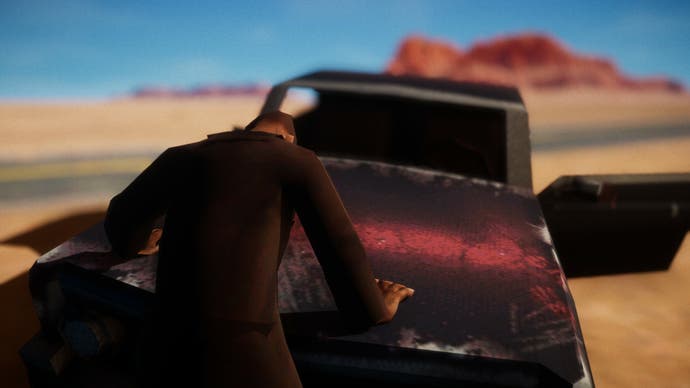
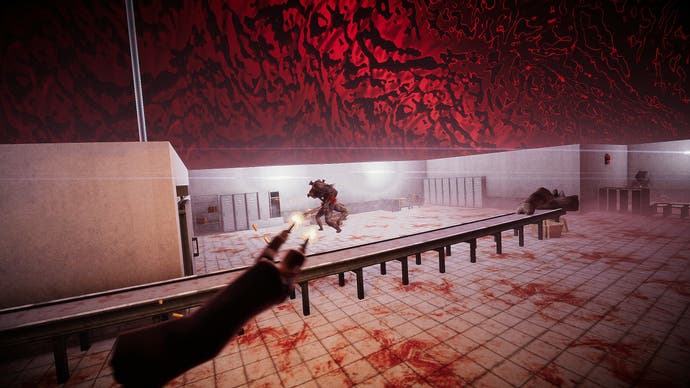
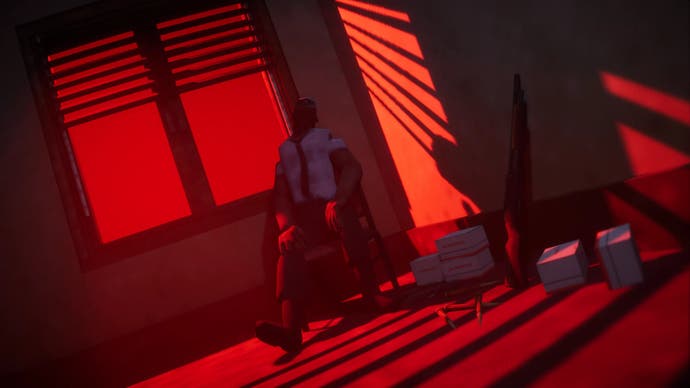
Weapons are good for keeping enemies at a distance, but my favourite element of the design may actually be stakes, which are used for dispatching smaller foes in one hit up-close when you're out of other options, and which are needed to finish some mini-bosses. Stakes are a great saviour when you think you're screwed, but they also tie neatly into the carnage you're unleashing. Almost everything in El Paso's world comes apart under gunfire, and this can be where you get fresh stakes from. You're killing but you're also collecting - looking out for ammo, which you always seem to be running out of, the pills that top up your health in a way that feels deeply inadvisable, and those stakes for when things go wrong.
The maze-like worlds you pass through, where everything is just itching to shatter and there are real, old-fashioned monster closets, are the final stylish element. Even early on, El Paso understands the liminal twitch and shudder of motels. Unlovely pictures will be hung upside down on the walls, perhaps, while there's nobody at reception, and in a side room a lamp will be knocked off a table. There's a kind of Lynchian subtlety at play here, little shortcuts for showing a world gone wrong in sparse, evocative vignettes before the monsters pop up.
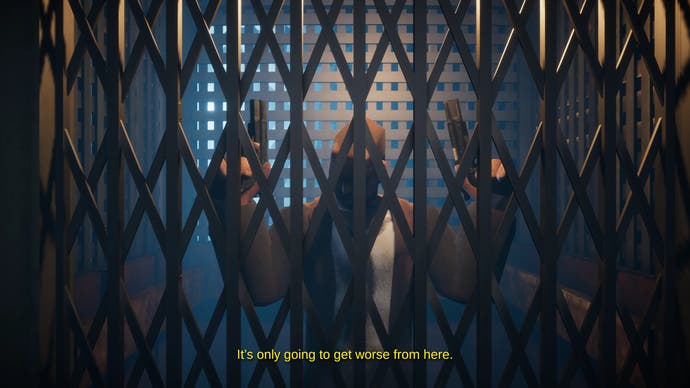
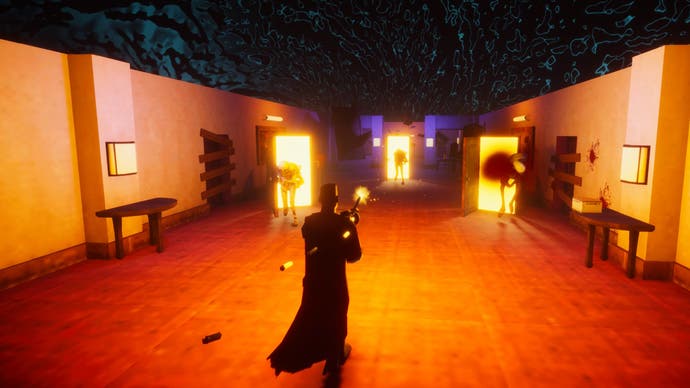
Then when things get berzerk, everything starts to shift. The motel phases into misty graveyards, ancient tombs, rotting mansions and abattoirs, before restlessly recombing assets. Doors will drop in from above, while a bedroom might have a projector beaming a ragged blank circle of light onto a wall. The music skips, the hero starts to sing along with the soundtrack, toilet stalls might hold a monster or ammo or - weirdest of all - another door where the toilet should be. Toilets! Literally, one level of hell is just toilets. But it's all staging, all pacing, and the game is as happy to hold things back and give you silence and a breather and space to walk and worry about what's next as it is to throw so many monsters at you at once that I eventually had to go into settings and scale back the effects and draw distance.
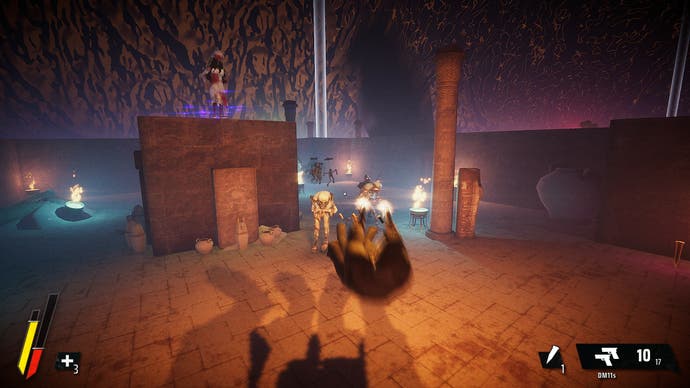
I'm left with details, as well as the breathlessness of a game that always ramps up the challenge. Details like the way each baddie dies, bullets lifting teleporting brides softly off their feet until they collapse like empty sheets, while the mummies double over, and the werewolves drive themselves into the ground in a crumpled tangle of limbs: commitment! Details like the level where the chaos amped up and the sound dropped away until it was just breathing rising and falling and catching on the audio. Details like the Ezekiel Machine angels that appear overhead and are so angular and inorganic that for a while I was blasting away wildly at them and only noticed after a minute or so that I was actually aiming at a chandelier by mistake. Details like a late turn in the narrative where the true theme emerged and the whole thing, against all odds, became quietly moving.
El Paso's wonderfully direct, but it's also just a lot. It's stylish and clever and striking in a way that few games are, and it feels both very old and utterly of the moment. At times it's so hectic that it's best to just switch to invincible and blast your way through, enjoying the wonderfully horrible scenery with its bulky props and vintage music video mists. At others, there's a thrill to juggling ammo, bullet-time, stake count and the advancing horde, and this thrill is so sharp it's worth the restarts. And yes, at times, the whole thing flung so much at the screen that my PC actually couldn't take it.
But I powered through, and I'm glad I did. El Paso's final level is gorgeous and unexpected and a perfect cap for everything that preceded it. Rattle the pills, ready the Cavalry, and call the elevator. And maybe afterwards give Repo Man another watch.
